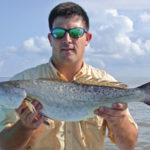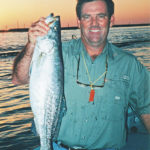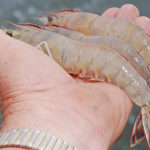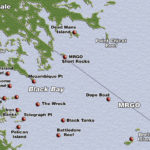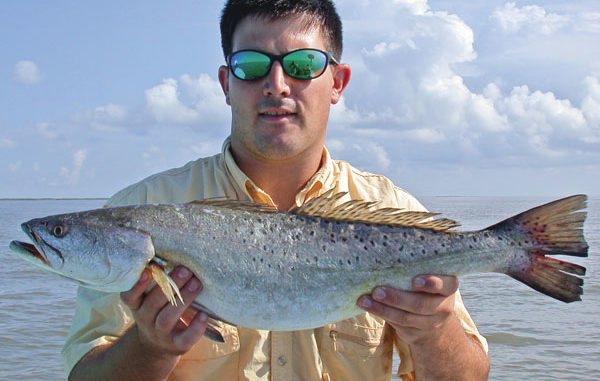
Hit the right locations with these techniques, and you’ll score on early season trophy specks.
The winter was long and hard. The images of decoying ducks and rutting bucks had long since passed, and thoughts of warm spring days on the open coast and large yellow mouths were only promises until today.
The cruel winds of March and April had reluctantly relinquished their grasp, and were replaced by a gentle southeasterly breeze that brought the clean, salty Gulf water into the bays and beaches of the Louisiana coastline, and with it, spawning specks.
Yes, the new fishing season was still in its infancy, but the unyielding optimism of those possessed with the pursuit of trophy speckled trout had yet to be tapped. This was the day when months of pent-up excitement would be unleashed.
The bay boat’s bow was now pointed to the south as the faint light of the new day sketched a spooky shadow across the bayou of men on a mission. Their destination this day would be the islands, reefs and rigs that ring Breton Sound.
But all across the Louisiana coast, others would be sharing this scene, heading south for the beaches, passes and other prime locations that form the world’s most prolific spawning grounds for speckled trout. They all shared the same hope and promise that new beginnings bring, seeking the thrill known only to those entranced by the pursuit of trophy specks.
Today would be the beginning of a springtime ritual, when big specks suddenly show up all along the Louisiana coast. The spawning specks had arrived!
The cycle of life along the coast begins with the necessity of each species to ensure its survival. As days lengthen and water temperatures and salinity levels rise, breeding-sized female specks begin to prepare for the spawning season.
Spawning can occur anytime between the months of February and October, when water temperatures reach about 68 degrees, but the prime time for spawning activity for the big sows is April and May. This is evident by looking at the top 10 specks taken in our state. Seven of these were caught during the months of April and May. While the month of April holds promise, its typical high winds and high river levels make it difficult for anglers to reach and properly fish the prime locations. More stable conditions arrive in May when fishing for spawning trophy specks reaches its peak during the full-moon stage.
While the biologists can give you the
scientific reasons why the biggest trout of the season are often caught during the early spawning cycles, all anglers need to know is that this is possibly the best time of the year to catch the fish of a lifetime, or even a new state record.
Fishing for trophy trout is not an easy quest, and is one that takes a lifetime to master. A trophy speck is defined differently for each angler and location fished. In the Breton Sound area, where I fish, a trout over 5 pounds could be considered a trophy. In the Venice area, it will take a fish 7 or more pounds to be outstanding, and in Lake Pontchartrain, it may take a fish over 8 pounds to turn heads. For most anglers, a trophy is simply their personal best or close to it.
I caught up with two trophy trout anglers in our area who are part of an elite group, both having caught a speckled trout that ranked in the top 10 in the state record book. They were happy to share their ideas on how to catch trophy fish. Their locations and techniques may be different, but they both share the same success and love for the sport. You may want to take lessons from these trout masters.
Weather conditions and moon phase
Capt. Dudley Vandenborre, who pursues trout in the Lake Pontchartrain area, knows about trophy trout. His top-10 speck weighed in at 10.50 pounds, and was caught on April 17, 2002, during the spring spawn.
“The fish always seem to be bigger in April and May,” said Vandenborre. “The other spawns [June-August] produce good fish, but if you really want a big fish, fish during the full moon phase of April and May.
“A lot of times the conditions are not quite right during the April spawn because the winds may be too high or the lake waters are too fresh (if the northshore rivers are high). May generally produces better fishing conditions.”
Vandenborre lets the wind dictate exactly where he fishes.
“In my area, I can move around a little and fish different areas depending on the wind direction and strength,” he said. “I don’t like anything from the west.”
Winds in excess of about 10 to 12 knots make fishing for trophy trout difficult because they create turbidity in the water, making the bait impossible for trout (who are sight feeders) to see. It also makes bait presentations and boat positioning a challenge.
According to Vandenborre, it takes about 12 to 18 hours after winds have subsided for the water to clean up.
“Many years, it is not until May that all the right conditions come together,” he said.
Vandenborre also believes strongly in fishing the full-moon stage.
“I like the three days before the full moon and the three days after the full moon best,” he said. “This May, the full moon phase will roughly run from May 14 through May 20. I suggest that you reserve some vacation days during that time if you are serious about big trout.”
Tides
Tides are also a critical factor during the early spawns because a good range and incoming tide with sufficient salinity levels are required to float the fertilized eggs from the bays into the estuaries, where they hatch and grow. In May, high tide is generally in the morning or early afternoon. This makes fishing the end of an incoming tide or the beginning of a falling tide convenient for anglers.
Ed Sexton, who fishes the Venice area, is also a dedicated trophy-trout angler. His personal best, a 10.50-pound trout caught on April 25, 2000, also makes the Louisiana top-10 record list.
“I don’t like a really strong tide, no more than a little over a foot,” he said. “I like to fish the last few hours of a rising tide.”
The best tidal range will differ for various areas across the coast. Vandenborre likes no more than a half-foot range. In the Black Bay and Breton Sound area, I have found that a tidal range between 1 and 2 feet is ideal. Like Sexton, I also like to fish the end of an incoming tide because the shallow areas have some clean water and the big trout seem to move into those shallow areas that have 2 to 3 feet of water on a high tide.
It’s important to study the tides in the area you fish and pick the best tides during the full-moon phase. You can refer to the Louisiana Sportsman Tide Tables in this issue or at www.louisianasportman.com.
Lake Pontchartrain
Vandenborre knows that there are many places to catch spawning trout in the lake. He also knows where the biggest ones hang out during the May spawn.
“I have caught almost all of my big fish on the Highway 11 bridge near the south shore,” he said. “The second best area would be the I-10 twin spans.
“The train trestle is a great place to catch numbers, but I have not found really big fish there.”
Vandenborre also fishes shoreline areas in the Salt Bayou and Irish Bayou areas around the rocks that are located there.
Venice
The Mississippi Delta is quite possibly the most productive fishing destination in North America. Big specks are part of what makes this area special. Sexton has an intimate knowledge of this area, and was happy to share where he has been successful.
“I do most of my fishing in May in the South Pass area including Redfish Bay, Blind Bay and Garden Island Bay,” he said. “On the west side, I’ll fish the Southwest Pass area.”
Breton Sound
Breton Sound is not known for record-book specks, but it is known for very good numbers of big fish in the 4- to 7-pound range. As an angler and charter captain, I find Breton Sound appealing because it gives the average angler a better chance at some big fish simply because there are more of them to catch there than in many other areas.
Anglers heading out from Shell Beach, Hopedale, Delacroix and Pointe a la Hache should look for the early season spawning specks near the close-in islands and points, underwater reefs and shallow-water rigs and wellheads.
My early-season favorites are Stone Island, the sunken reefs at Lonesome Island and Snake Island, Iron Banks and the close-in rigs such as The Wreck, its companion rig and the rigs a little farther out such as the old Black Tanks and Five Wells.
The Battledore area is a wild card, but can produce if the river is low and not flooding the area with fresh water.
Baits, techniques and gear
When it comes to baits, it is important to understand how big fish feed. They are looking for a big meal, and that usually means a 4- to 6-inch finfish such as a mullet, croaker, bay anchovy, pogy (menhaden) or glass minnow. Shrimp are normally not a large part of a big trout’s diet.
Whether you choose to fish live bait or artificial, make sure it is big enough so that you are not targeting smaller trout before the big ones can get to your bait. If you like to fish live bait, you will normally not find the right-sized bait to catch trophy trout in bait shops, so you will have to catch it yourself.
For many, some of the larger artificials are the baits of choice, but they require more finesse and skill than live bait. Artificials can be topwater or sinking hard baits, or soft jerk or swimming baits. All of these produce when fished in the proper way.
Sexton loves to fish topwater baits.
“I don’t just fish topwater in the early morning or evening,” he said, “I will sometimes break them out at noon and have good success.”
Sexton is a fan of Top Dogs, and uses the darker colors in low light conditions and lighter colors when it is bright. Normally Sexton will fish topwaters in fairly shallow areas of 3 to 4 feet of water, but has caught fish on them in as deep as 20 feet of water.
“As far as gear goes, all of my rods are 7 feet,” he said. “I use a baitcasting rod and reel except when I’m fishing live bait; then I use spinning gear.”
Sexton uses a “walk-the-dog” technique, and when he gets a strike, he only takes in slack until he feels the fish on.
“You should never set the hook hard (like bass fishing) when fishing topwater,” he said. “Let the fish hook themselves.”
Sexton uses his trolling motor extensively and also has a Power-Pole. He normally only anchors if he has found a good location and wants to fish that spot thoroughly.
Vandenborre likes to fish on the bottom in the lake, and primarily uses plastic swim baits. Of course, his favorite is the Deadly Dudley, the V&G lure that he created and sells. For big fish during the spawn, he uses the larger original Deadly Dudley and one of his newer baits, the Bay Chovey, and normally uses a 3/8-ounce jighead.
Vandenborre said the most important thing when fishing these baits is to throw the lure as close as possible (3 to 6 inches) to the piling and let it go straight down to the bottom.
“Work the bait very slowly with small bounces,” he said. “Keep in contact with the bait at all times so you can feel the faint strike to set the hook.
“Most strikes will come when the bait is falling.”
Vandenborre’s top two colors are blue moon and avocado (in low light conditions).
In the Black Bay and Breton Sound area, live bait is king. When fishing live bait, I try to drift into the spot, if possible, and use my trolling motor only when necessary. The preferred rig when using finger mullets or croakers is freelining. I tie a 2/0 kahle hook directly to the end of my 14-pound-test mono fishing line using a 7-foot spinning rod with medium action. If wind and tidal conditions require it, I use a small split-shot about 18 inches above the hook.
A Carolina sliding-sinker rig can also be used if the tide and wind are too strong, but it will hinder the action of the live bait. The bait is hooked through the lips and is tossed as far upcurrent as possible so that the live bait can freely swim or drift back with the current.
Always keep the slack out of the line so that you can feel the bite. When you do, give the fish some slack and let him completely swallow the bait. I usually wait until I see and feel the line begin to move sideways. It may take four to seven seconds (which is an eternity) before I pull up the rod and set the hook.
When fishing for trout, a popping cork with bait under it will normally produce a pile of smaller fish, but if you are after the big ones, a large bait tied directly to your line is a much better choice.
Trophy Attitude
Perhaps the most valuable possession for trophy trout fishing cannot be purchased at a sporting-goods store or acquired from reading a magazine. It is a trophy attitude. No matter where you fish or what bait you use, you must have unwavering confidence and a winning attitude.
“You have to be willing to fish long and hard and only catch a few fish,” said Sexton. “I would rather catch 10 or 15 good fish than a limit of smaller ones.”
You must be willing to pay the price and do whatever it takes to succeed, even when you are not filling up the ice chest like others around you. Like a trophy deer hunter who lets smaller bucks walk, you must be content to know that catching a limit is not your goal. Instead, a few extraordinary fish are what you desire and seek.
It is not for everyone, but without a trophy attitude you will quickly give up on big fish and return to the numbers game. There is nothing wrong with wanting to catch numbers of fish, and you may wind up catching a state record anyway, but to consistently catch trophy fish, you must have a trophy attitude and always be seeking new ways of perfecting your technique with the goal of catching the trout of a lifetime.
